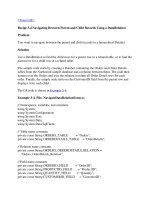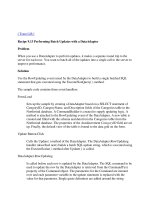Tài liệu Using a Transaction with a DataAdapter pptx
Bạn đang xem bản rút gọn của tài liệu. Xem và tải ngay bản đầy đủ của tài liệu tại đây (14.38 KB, 4 trang )
[ Team LiB ]
Recipe 6.5 Using a Transaction with a DataAdapter
Problem
You need to use a transaction when updating a data source using a DataAdapter.
Solution
Associate a Transaction with the appropriate Command object from the DataAdapter.
The sample code contains three event handlers:
Form.Load
Sets up the sample by using a DataAdapter to load a DataTable with the Orders
table from the Northwind database. A CommandBuilder is used to generate the
updating logic. The default view of the DataTable is bound to a data grid on the
form.
Update Button.Click
Creates a new Transaction object on the Connection of the SelectCommand of the
DataAdapter. The Transaction is associated with the Connection objects for the
update commands generated for the DataAdapter by the CommandBuilder. The
Update( ) method of the DataAdapter is called to update DataTable changes to the
Orders table. If no errors are encountered, the transaction is committed; otherwise,
all changes made are rolled back.
Refresh Button.Click
Clears and reloads the Orders DataTable.
The C# code is shown in Example 6-7
.
Example 6-7. File: TransactionDataAdapter.cs
// Namespaces, variables, and constants
using System;
using System.Configuration;
using System.Windows.Forms;
using System.Data;
using System.Data.SqlClient;
private const String ORDERS_TABLE = "Orders";
private DataTable dt;
private SqlDataAdapter da;
private SqlCommandBuilder cb;
// . . .
private void TransactionDataAdapterForm_Load(object sender,
System.EventArgs e)
{
String sqlText = "SELECT * FROM Orders";
// Fill the Orders table for editing.
da = new SqlDataAdapter(sqlText,
ConfigurationSettings.AppSettings["Sql_ConnectString"]);
// Stop updating when an error is encountered for roll back.
da.ContinueUpdateOnError = false;
// Create CommandBuilder and generate updating logic.
cb = new SqlCommandBuilder(da);
cb.GetDeleteCommand( );
cb.GetInsertCommand( );
cb.GetUpdateCommand( );
// Create table and fill with orders schema and data.
dt = new DataTable(ORDERS_TABLE);
da.FillSchema(dt, SchemaType.Source);
da.Fill(dt);
// Bind the default view of the table to the grid.
dataGrid.DataSource = dt.DefaultView;
}
private void updateButton_Click(object sender, System.EventArgs e)
{
// Create and open the connection.
SqlConnection conn = new SqlConnection(
ConfigurationSettings.AppSettings["Sql_ConnectString"]);
conn.Open( );
// Create and start the transaction.
SqlTransaction tran = null;
tran = conn.BeginTransaction( );
// Associate CommandBuilder generated update commands
// with the transaction.
da.SelectCommand.Transaction = tran;
// Update the data source.
try
{
// Submit the changes.
da.Update(dt);
// Success. Commit.
tran.Commit( );
}
catch (Exception ex)
{
// Exception. Roll back.
tran.Rollback( );
MessageBox.Show(ex.Message + Environment.NewLine +
"Transaction rolled back.");
}
finally
{
conn.Close( );
}
}
private void refreshButton_Click(object sender, System.EventArgs e)
{
// Refresh the orders data.
dt.Clear( );
da.Fill(dt);
}
Discussion
You can use a transaction with a DataAdapter to allow the roll back of updates made by
the DataAdapter in the event of an error.
If, as in the solution, a CommandBuilder is used to generate the update logic for the
DataAdapter, associate the Transaction with the SelectCommand of the DataAdapter as
shown in the solution code:
da.SelectCommand.Transaction = tran;
If custom update logic is used for the DataAdapter, the Transaction must be associated
with the DeleteCommand, InsertCommand, and UpdateCommand of the DataAdapter,
but not the SelectCommand, as shown in the following code:
da.DeleteCommand.Transaction = tran;
da.InsertCommand.Transaction = tran;
da.UpdateCommand.Transaction = tran;
[ Team LiB ]









